Dune Volume Changes at Decadal Timescales and Its Relation with Potential Aeolian Transport
Abstract
1. Introduction
- To gain insight into long-term dune development at the Belgian coast. This study is based on the analysis of airborne photogrammetric and airborne laser scanner (LiDAR) data of the dunes from 1979–2018.
- To gain insight into annual potential aeolian sediment transport quantities and how it behaves on decadal timescales (long-term). Annual potential aeolian sediment transport along the Belgian coastline is estimated by the use of a modified Bagnold model, which has been validated by short-term field data of aeolian sediment transport rates [14], applied to a wind data set from 2000–2017.
- To gain insight into the correlation between observed and predicted dune volume on an annual timescale. Year-to-year variations (between elevation measurements) in potential transport and dune volume changes are compared.
- To gain insight into the correlation between observed and predicted dune volume on decadal timescales. Trend analysis on predicted and measured dune volume is conducted for comparisons on a decadal timescale.
- To explain longshore variations of the correlations by distinguishing between ‘natural’ and ‘managed’ beach sections of the Belgian coast featuring dunes.
2. Regional Setting
3. Methods
3.1. Dune Volume Changes Along the Belgian Coast
3.2. Calculation Procedure of Potential Transport
4. Results and Discussion
4.1. Spatial–Temporal Variability in Dune Volume Changes: Linear Trends
4.2. Typical Management Strategies and Their Effect on Dune Behavior
4.2.1. Influence of Dune Foot Reinforcement
4.2.2. Effect of Dune Blowouts
4.2.3. Influence of Dune Foot Protection Measures
4.2.4. Combined Influence of Nourishments and Brushwood Fences
4.2.5. Influence of Excavation Works
4.3. Potential Aeolian Sediment Transport
4.4. Correlation between Potential Transport and Dune Volume Changes
4.4.1. Correlation on Annual Timescales
- Method 1: The first method compares dune erosion and dune growth with corresponding potential transport. Net potential transport is calculated based on the full wind rose (onshore and offshore winds).
- Method 2: The second method compares dune erosion and dune growth with corresponding potential transport based solely on onshore winds. It is assumed here that offshore winds do not extract sediment from the dune seawards. As mentioned before, dunes are, besides aeolian processes, also influenced by marine erosive processes.
- Method 3: The third and last method compares only the periods with dune growth with the corresponding potential transport based solely on onshore winds. Offshore winds are not used in the calculation procedure.
- According to Equation (1), potential aeolian sediment transport is proportional to the cube of shear velocity, meaning that high winds above the threshold contribute exponentially to the annual sum of potential transport (Equation (4)). Although these winds are able to transport large amounts of sediment, they tend to create high water levels and long wave run-ups as well.
- Between consecutive LiDAR flights, dune erosion and dune growth can occur. Even during strong aeolian transport events, a single dune-erosion event can undo any dune growth that happened before that storm.
- The period between two consecutive LiDAR flights is also too long, resulting in a coarse spatial–temporal data set.
4.4.2. Correlation on Decadal Timescales
5. Conclusions
- Along the Belgian coast, concerning the coastal sections with vegetated dunes (approximately half of the coast), it is found that the dunes grow at a constant rate. Linear regression analysis shows that 80% of the dune sections have linear correlations higher than 0.9. There is alongshore variability in linear dune growth rates at the Belgian coast and they are found to be in the order of 0–12.3 m3/m/year. An average dune growth of 6.2 m3/m/year has been found.
- Considering all coastal dune sections within the period of 2000–2017, onshore potential aeolian sediment transport ranges up to 9 m3/m/year (average = 5.2 m3/m/year), while longshore potential aeolian sediment transport could reach up to 20 m3/m/year (average = 18.7 m3/m/year). This means that total potential transport along the Belgian coastline is, on average, 20 m3/m/year. The main direction of aeolian sediment transport on the Belgian coast is from west to southwest. West to southwestern winds are oblique onshore to longshore with respect to the Belgian coastline. The larger parallel component (longshore) of the potential transport drift is directed towards the northeast (the Netherlands), while the normal component (onshore) is directed towards the southeast (hinterland).
- There was no significant relationship between annual wind and dune volume change in the alongshore direction. However, a significant correlation is found between potential and observed dune volume development on a decadal timescale, indicating that dune growth is primarily caused by aeolian sediment transport from the beach. Most of the predicted data are within a factor of two of the measured values. The finding of potentially stronger correlations at the Belgian coast are most likely caused by the wider beaches (between 150 m and 400 m) due to the massive sand nourishments to keep the sediment budgets along the Belgian coast positive. It also suggests that annual differences in forcing and transport limiting conditions (wind speed and surface conditions) only have a slight effect on the overall variability of dune volume trends.
Author Contributions
Funding
Acknowledgments
Conflicts of Interest
References
- Nickling, W.G.; Davidson-Arnott, R.G.D. Aeolian sediment transport on beaches and coastal sand dunes. In Proceedings of the Canadian Symposium on Coastal Sand Dunes, Guelph, ON, Canada, 12–14 September 1990; pp. 1–35. [Google Scholar]
- Delgado-Fernandez, I.; Davidson-Arnott, R.G.D. Sediment Input to Foredunes Description and Frequency of Transport Events at Greenwich Dunes, PEI, Canada. J. Coast. Res. 2009, 1, 302–306. [Google Scholar]
- Baas, A.C.W.; Sherman, D.J. Spatiotemporal Variability of Aeolian Sand Transport in a Coastal Dune Environment. J. Coast. Res. 2006, 22, 1198–1205. [Google Scholar] [CrossRef]
- De Vries, S.; Southgate, H.N.; Kanning, W.; Ranasinghe, R. Dune behavior and aeolian transport on decadal timescales. Coast. Eng. 2012, 67, 41–53. [Google Scholar] [CrossRef]
- Vellinga, P. Beach and dune erosion during storm surges. Coast. Eng. 1986, 6, 361–387. [Google Scholar] [CrossRef]
- Steetzel, H.J. Cross-Shore Transport during Storm Surges. Ph.D. Thesis, TU Delft, Delft, The Netherlands, 1993. [Google Scholar]
- Van Rijn, L.C. Erosion of Coastal Dunes Due to Storms; Leovanrijn-Sediment: Blokzijl, The Netherlands, 2013; pp. 1–18. [Google Scholar]
- Delgado-Fernandez, I. Meso-scale modelling of aeolian sediment input to coastal dunes. Geomorphology 2011, 130, 230–243. [Google Scholar] [CrossRef]
- Strypsteen, G.; Montreuil, A.L.; Rauwoens, P. Aeolian sand transport at the Belgian coast: Field campaigns and fist results. In Proceedings of the Coastal Dynamics 2017, Helsingør, Denmark, 12–16 June 2017. [Google Scholar]
- Sarre, R.D. Aeolian sand drift from the intertidal zone on a temperate beach: Potential and actual rates. Earth Surf. Process. Landf. 1989, 14, 247–258. [Google Scholar] [CrossRef]
- Dingler, J.R.; Hsu, S.A.; Reiss, T.E. Theoretical and measured aeolian sand transport on a barrier island, Louisiana, USA. Sedimentology 1992, 39, 1031–1043. [Google Scholar] [CrossRef]
- Jackson, N.L.; Nordstrom, K.F. Effects of time-dependent moisture content of surface sediments on aeolian transport rates across a beach, Wildwood, NJ, USA. Earth Surf. Process. Landf. 1997, 22, 611–621. [Google Scholar] [CrossRef]
- Nordstrom, K.F. Offshore Aeolian Transport across a Beach: Carrick Frinn Strand, Ireland. J. Coast. Res. 1996, 12, 664–672. [Google Scholar]
- Strypsteen, G.; van Rijn, L.C.; Rauwoens, P. On the relation between predicted and observed aeolian transport rates: A field study at the Belgian coast. Aeolian Res. 2019. under review. [Google Scholar]
- Law, M.N.; Davidson-Arnott, R.G.D. Seasonal controls on aeolian processes on the beach and foredune. In Proceedings of the Canadian Symposium on Coastal Sand Dunes, Guelph, ON, Canada, 12–14 September 1990; pp. 49–68. [Google Scholar]
- Pye, K.; Blott, S.J. Decadal-scale variation in dune erosion and accretion rates: An investigation of the significance of changing storm tide frequency and magnitude on the Sefton coast, UK. Geomorphology 2008, 102, 652–666. [Google Scholar] [CrossRef]
- Brodie, K.; Conery, I.; Cohn, N.; Spore, N.; Palmsten, M. Spatial Variability of Coastal Foredune Evolution, Part A: Timescales of Months to Years. J. Mar. Sci. Eng. 2019, 7, 124. [Google Scholar] [CrossRef]
- Keijsers, J.G.S.; Poortinga, A.; Riksen, M.J.P.M.; Maroulis, J. Spatio-temporal variability in accretion and erosion of coastal foredunes in the Netherlands: Regional climate and local topography. PLoS ONE 2014, 9, e91115. [Google Scholar] [CrossRef] [PubMed]
- Bagnold, R.A. The Physics of Blown Sand and Desert Dunes, 2nd ed.; Methuen: London, UK, 1954; pp. 1–265. [Google Scholar]
- Kadib, A.A. A Function for Sand Movement by Wind; FAO: Rome, Italy, 1965; pp. 1–103. [Google Scholar]
- Hsu, S.A. Computing Eolian sand transport from routine weather data. In Proceedings of the 14th International Conference on Coastal Engineering, Copenhagen, Denmark, 24–28 June 1974; pp. 1619–1626. [Google Scholar]
- McKee, E. A Study of Global Sand Seas; US Government Printing Office: Washington, DC, USA, 1979; pp. 1–439.
- Kroon, A.; Hoekstra, P. Eolian Sediment Transport on a Natural Beach. J. Coast. Res. 1990, 6, 367–379. [Google Scholar]
- Vandebroek, E.; Dan, S.; Vanlede, J.; Verwaest, T.; Mostaert, F. Sediment Budget for the Belgian Coast: Final Report; Antwerp & Antea Group: Antwerpen, Belgium, 2017; pp. 1–105. [Google Scholar]
- Charlier, R.H.; De Meyer, C.P. New Developments on Coastal Protection along the Belgian Coast. J. Coast. Res. 1995, 11, 1287–1293. [Google Scholar]
- Lebbe, L.; Van Meir, N.; Viaene, P. Potential Implications of Sea-Level Rise for Belgium. J. Coast. Res. 2008, 24, 358–366. [Google Scholar] [CrossRef]
- Verwaest, T.; Vanpoucke, P.; Vanderkimpen, P.; Van der Biest, K.; Reyns, J.; Peeters, P.; Kellens, W.; Vanneuville, W.; Mostaert, F. Overstromingsrisico’s aan de Vlaamse Kust. Evaluatie van de Zeewering: Deel 1. Methodologie; WL Rapporten, 718_2A; Waterbouwkundig Laboratorium/Universiteit Gent/Soresma/Haecon: Antwerpen, Belgium, 2008; pp. 1–225. [Google Scholar]
- Haerens, P.; Bolle, A.; Trouw, K.; Houthuys, R. Definition of storm thresholds for significant morphological change of the sandy beaches along the Belgian coastline. Geomorphology 2012, 143–144, 104–117. [Google Scholar] [CrossRef]
- International Marine & Dredging Consultants (IMDC). DO4: Morfologische Evolutie van de Vlaamse Kust Ingedeeld in Morfologisch Homogene Kuststroken, vanaf de Eerste Meetvlucht tot 2009; Rekening Houdend Met de Aangevoerde Zandhoeveelheden: Oostende, Belgium, 2010; pp. 1–86. [Google Scholar]
- Houthuys, R. Morfologie van de Vlaamse Kust in 2011, Agentschap Maritieme Diensverlening en Kust; Afdeling Kust: Oostende, Belgium, 2012; pp. 1–150. [Google Scholar]
- Deronde, B.; Houthuys, R.; Henriet, J.P.; Van Lancker, V. Monitoring of the sediment dynamics along a sandy shoreline by means of airborne hyperspectral remote sensing and LIDAR: A case study in Belgium. Earth Surf. Process. Landf. 2009, 34, 155–161. [Google Scholar] [CrossRef]
- Revell, D.L.; Komar, P.D.; Sallenger, A.H. An application of LIDAR to analyses of El Niño erosion in the Netarts littoral cell, Oregon. J. Coast. Res. 2002, 18, 792–801. [Google Scholar]
- Sallenger, A.H., Jr.; Krabill, W.B.; Swift, R.N.; Brock, J.; List, J.; Hansen, M.; Holman, R.A.; Manizade, S.; Sontag, J.; Meredith, A.; et al. Evaluation of airborne topographic LIDAR for quantifying beach changes. J. Coast. Res. 2003, 19, 125–133. [Google Scholar]
- White, S.A.; Wang, Y. Utilizing DEMs derived from LIDAR data to analyze morphologic change in the North Carolina coastline. Remote Sens. Environ. 2003, 85, 39–47. [Google Scholar] [CrossRef]
- Stockdon, H.; Sallenger, A.; List, J.; Holman, R. Estimation of shoreline position and change using airborne topographic LIDAR data. J. Coast. Res. 2002, 18, 502–513. [Google Scholar]
- Delgado-Fernandez, I.; Davidson-Arnott, R.G.D. Meso-scale aeolian sediment input to coastal dunes: The nature of aeolian transport events. Geomorphology 2011, 126, 217–232. [Google Scholar] [CrossRef]
- Arens, S.M. Transport rates and volume changes in a coastal foredune on a Dutch Wadden island. J. Coast. Conserv. 1997, 3, 49–56. [Google Scholar] [CrossRef]
- Van Rijn, L.C. Aeolian Transport over a Flat Sediment Surface; Leovanrijn-Sediment: Blokzijl, The Netherlands, 2018; pp. 1–33. [Google Scholar]
- Sherman, D.J.; Li, B. Predicting aeolian sand transport rates: A reevaluation of models. Aeolian Res. 2012, 3, 371–378. [Google Scholar] [CrossRef]
- Valance, A.; Rasmussen, K.R.; Ould El Moctar, A.; Dupont, P. The physics of Aeolian sand transport. Comptes Rendus Phys. 2015, 16, 105–117. [Google Scholar] [CrossRef]
- Davidson-Arnott, R.G.D.; Law, M.N. Measurement and Prediction of Long-Term Sediment Supply to Coastal Foredunes. J. Coast. Res. 1996, 12, 654–663. [Google Scholar]
- Lynch, K.; Jackson, D.W.T.; Cooper, J.A.G. Aeolian fetch distance and secondary airflow effects: The influence of micro-scale variables on meso-scale foredune development. Earth Surf. Process. Landf. 2007, 33, 991–1005. [Google Scholar] [CrossRef]
- Delgado-Fernandez, I. A review of the application of the fetch effect to modelling sand supply to coastal foredunes. Aeolian Res. 2010, 2, 61–70. [Google Scholar] [CrossRef]
- Spies, P.J.; McEwan, I.K. Equilibration of saltation. Earth Surf. Process. Landf. 2000, 25, 437–453. [Google Scholar] [CrossRef]
- Van Rijn, L.C.; Walstra, D.J.R. Modelling of Sand Transport in DELFT3D; Deltares: Delft, The Netherlands, 2003; pp. 1–154. [Google Scholar]
- Ruz, M.H.; Anthony, E.J. Sand trapping by brushwood fences on a beach-foredune contact: The primacy of the local sediment budget. Z. Geomorphol. Suppl. Issues 2008, 52, 179–194. [Google Scholar] [CrossRef]
| 1 | TAW is the Belgian reference level (Tweede Algemene Waterpassing) and is located around mean water level at low tide springs. |
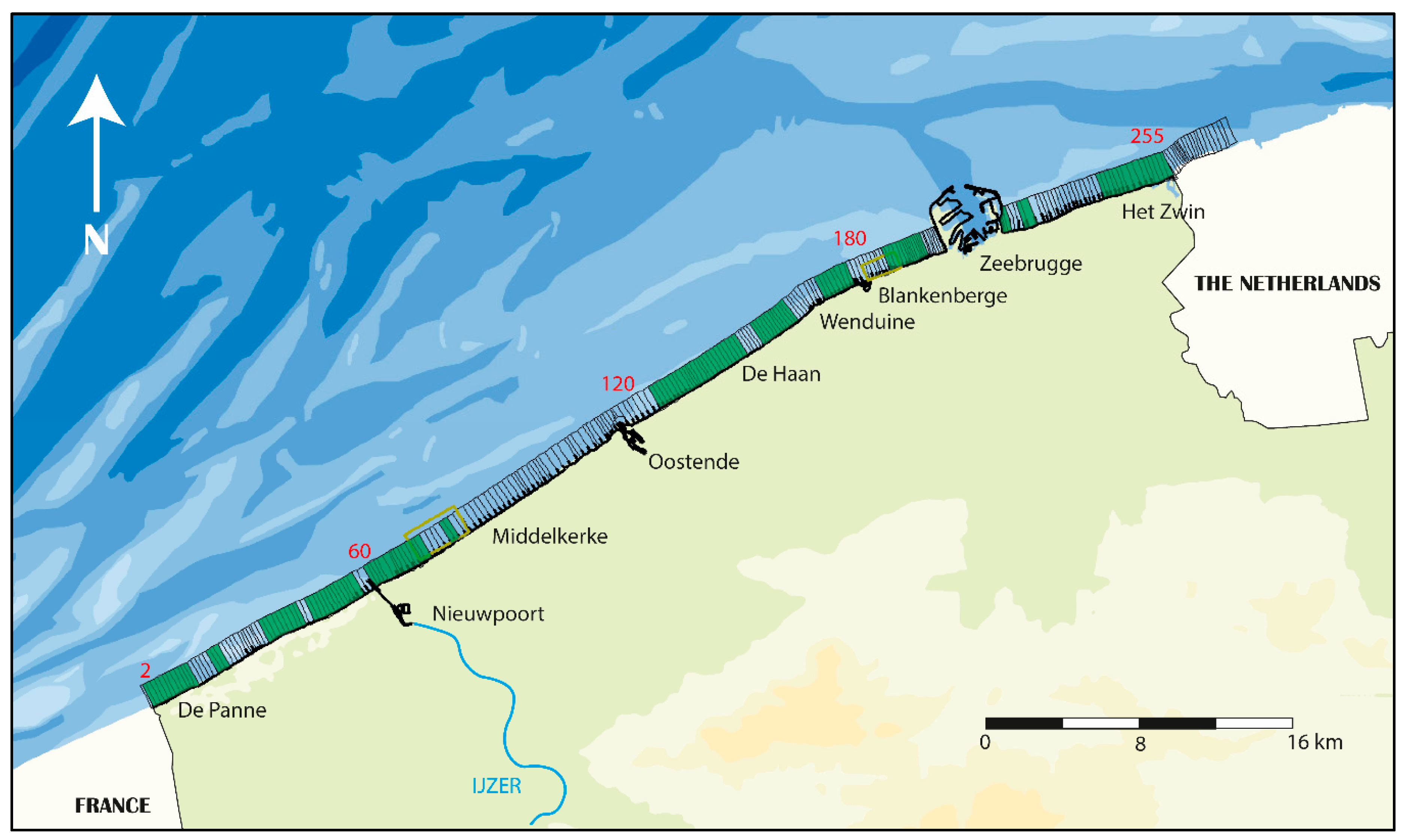
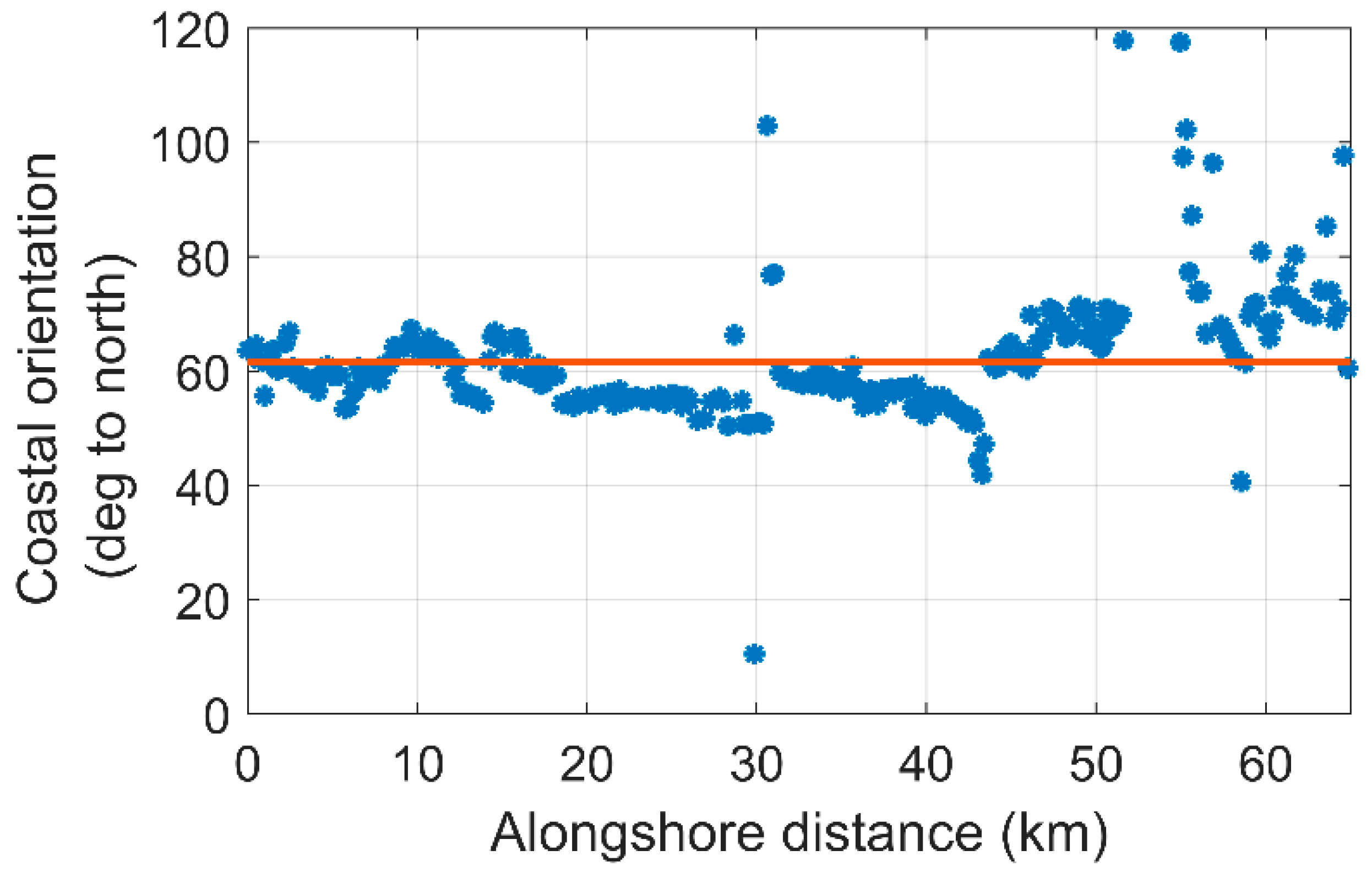
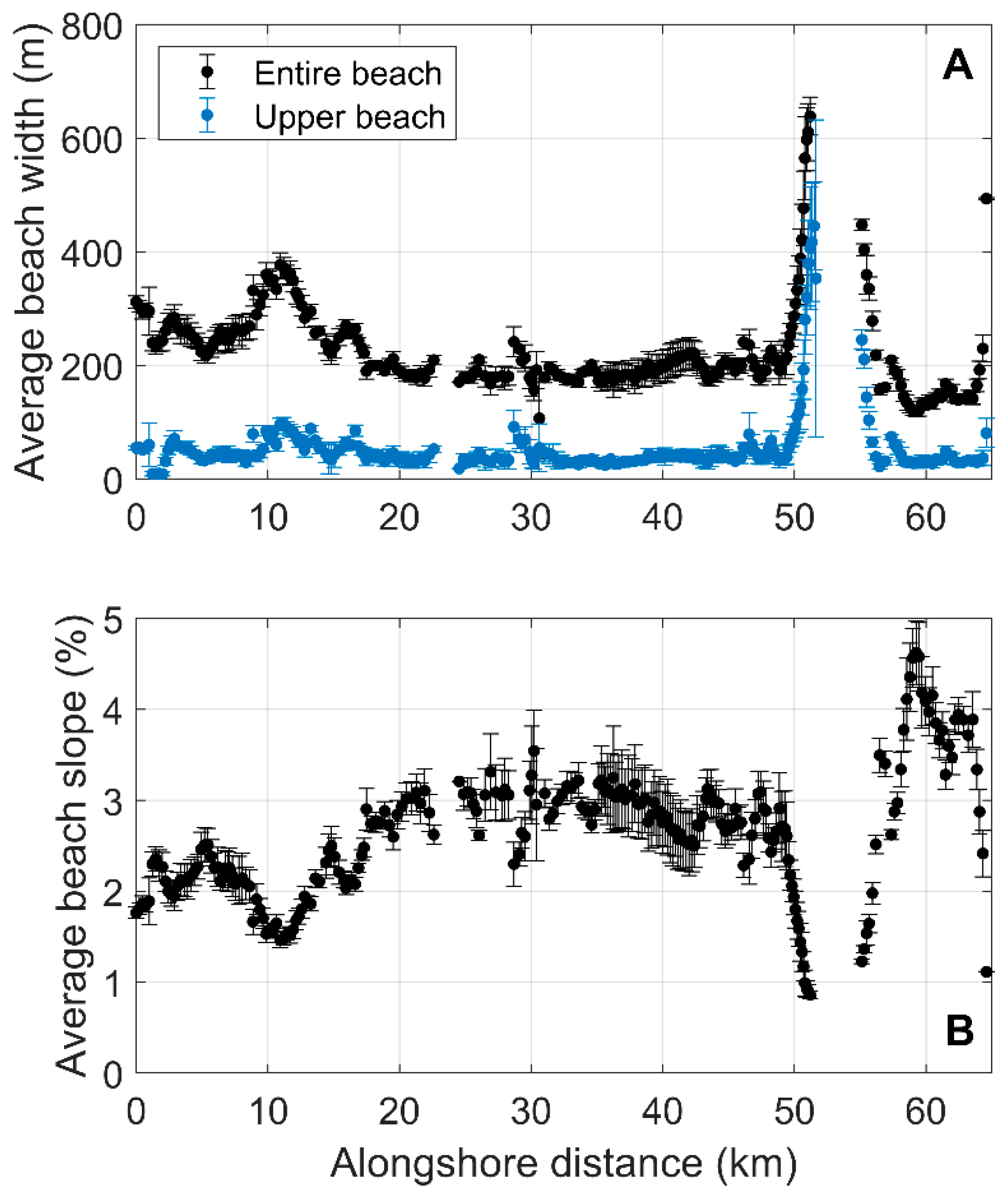
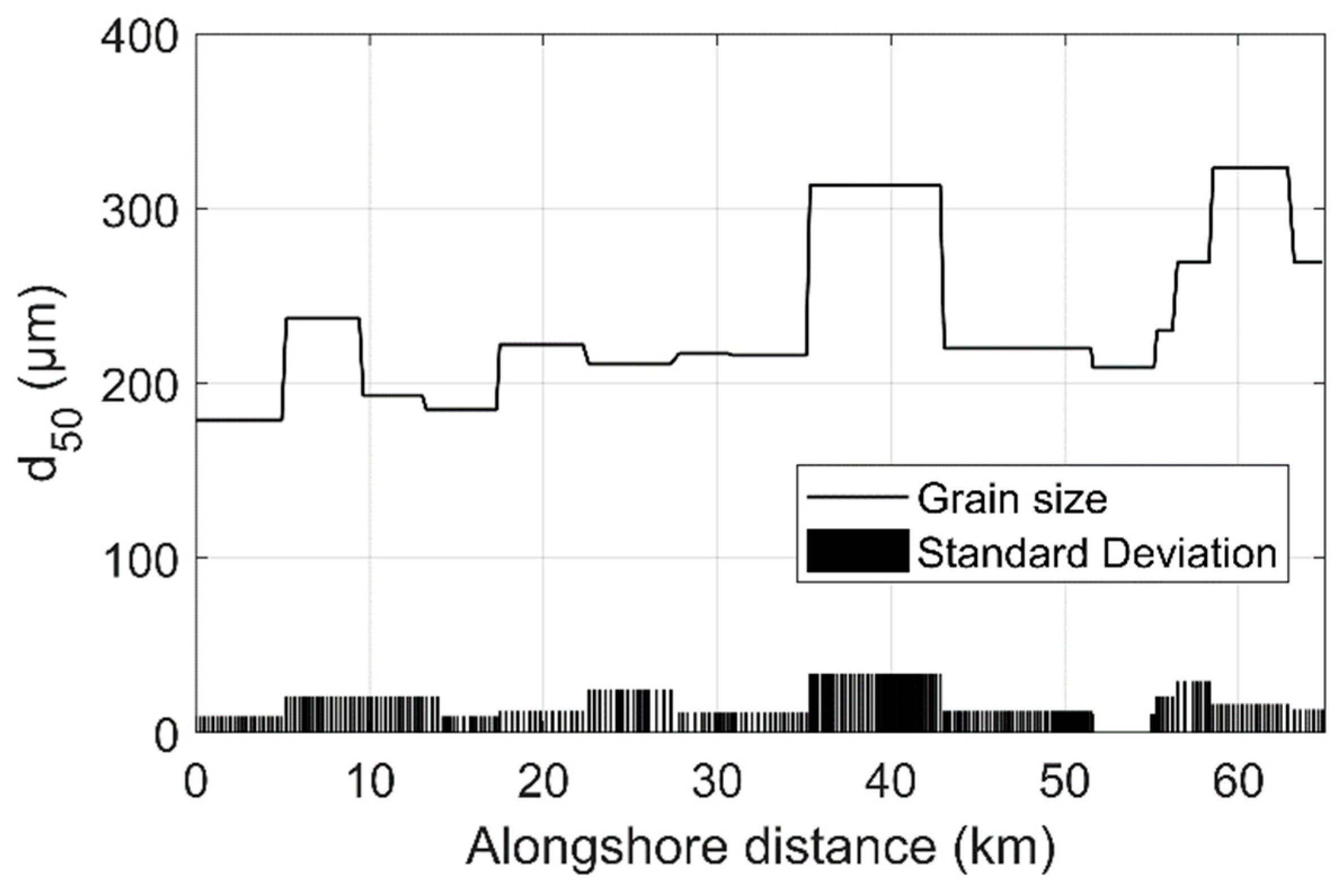


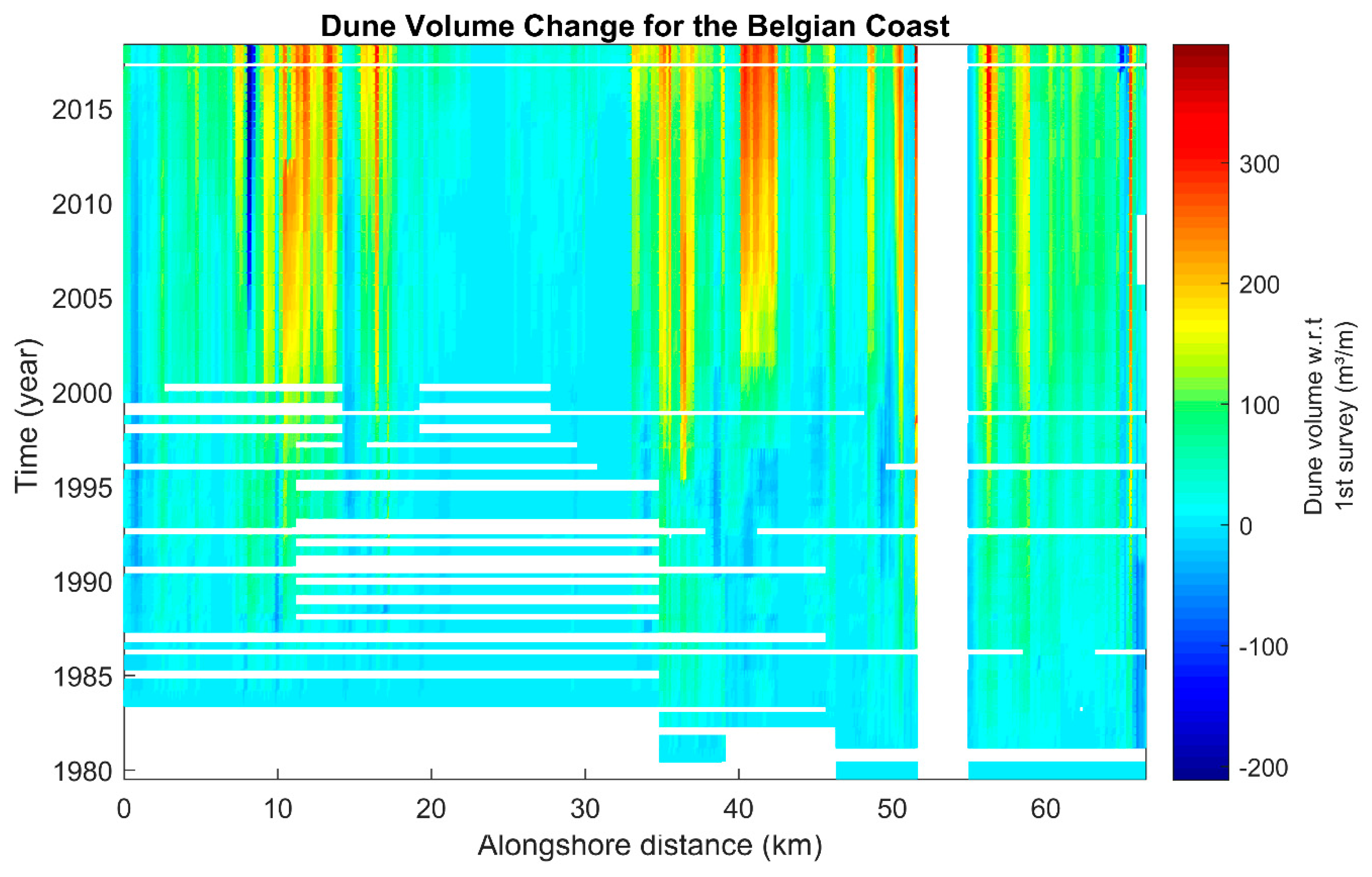
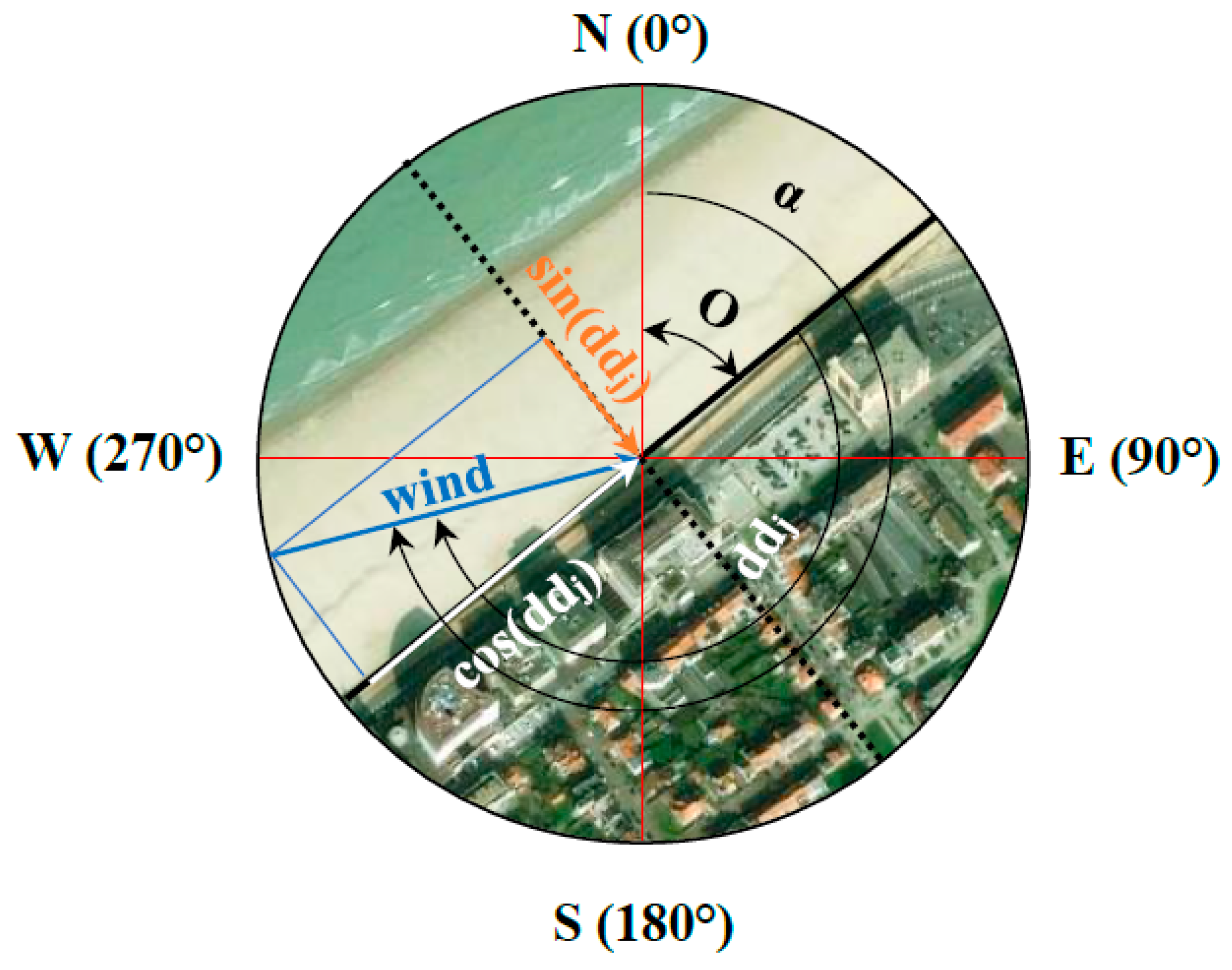
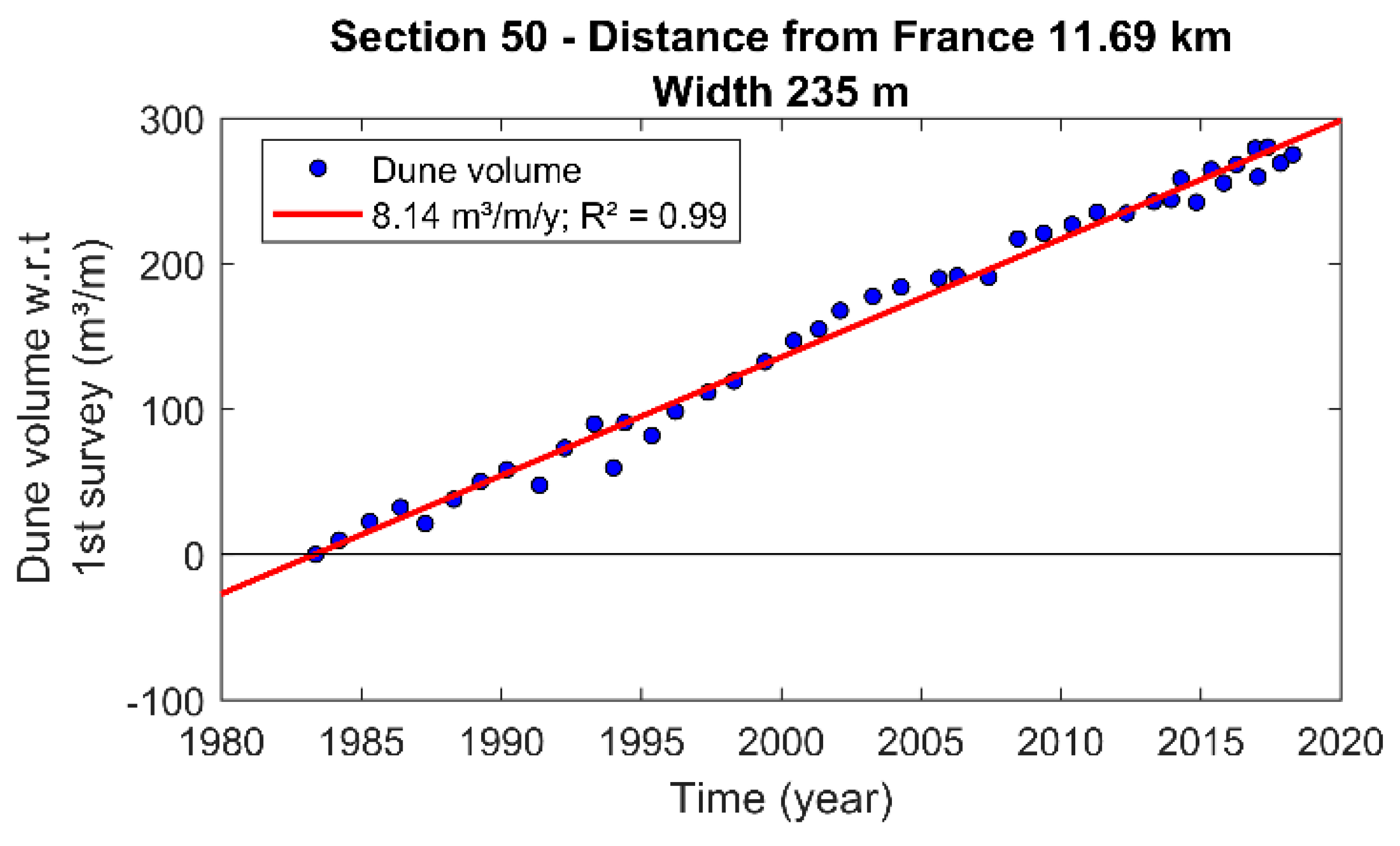
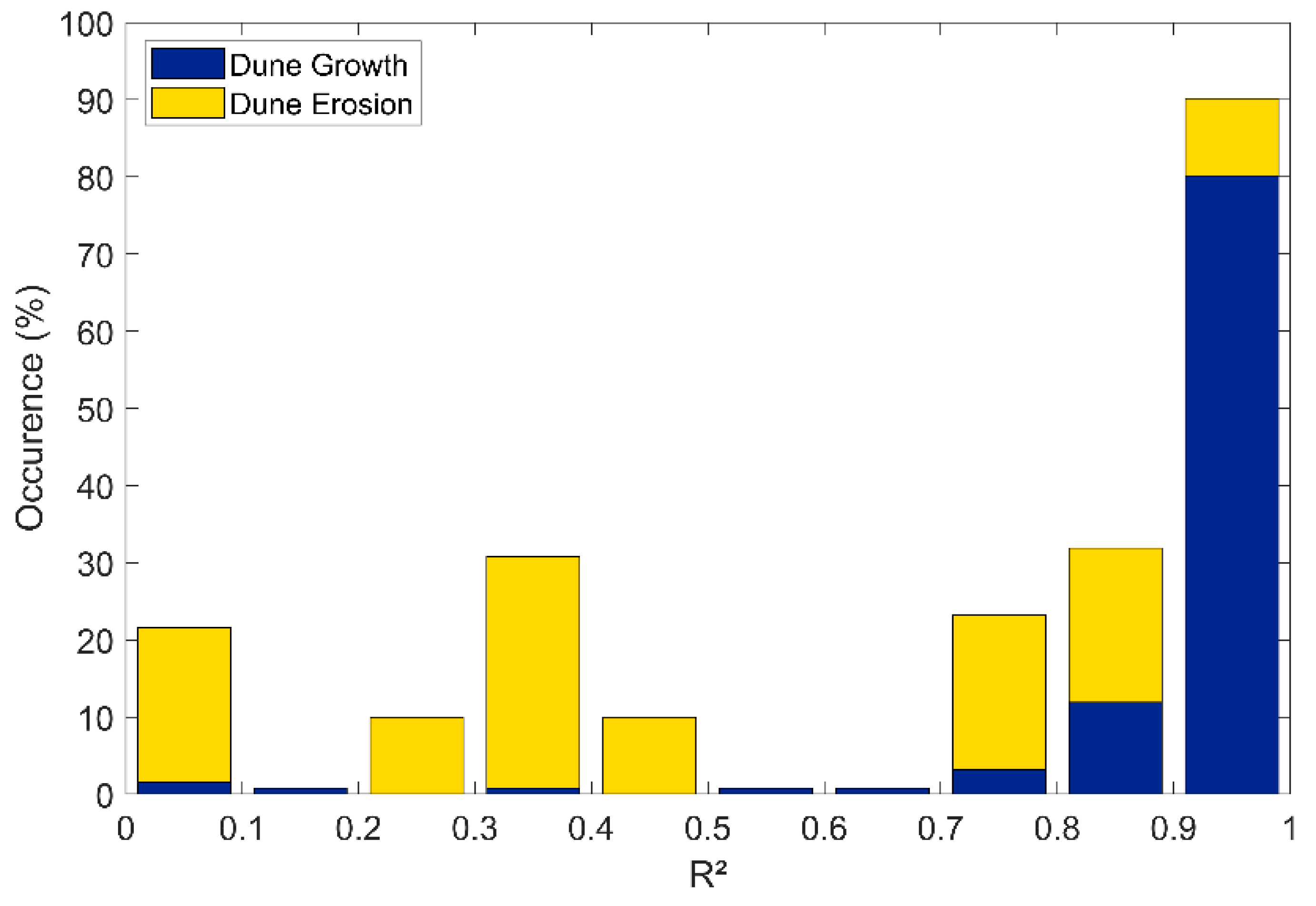


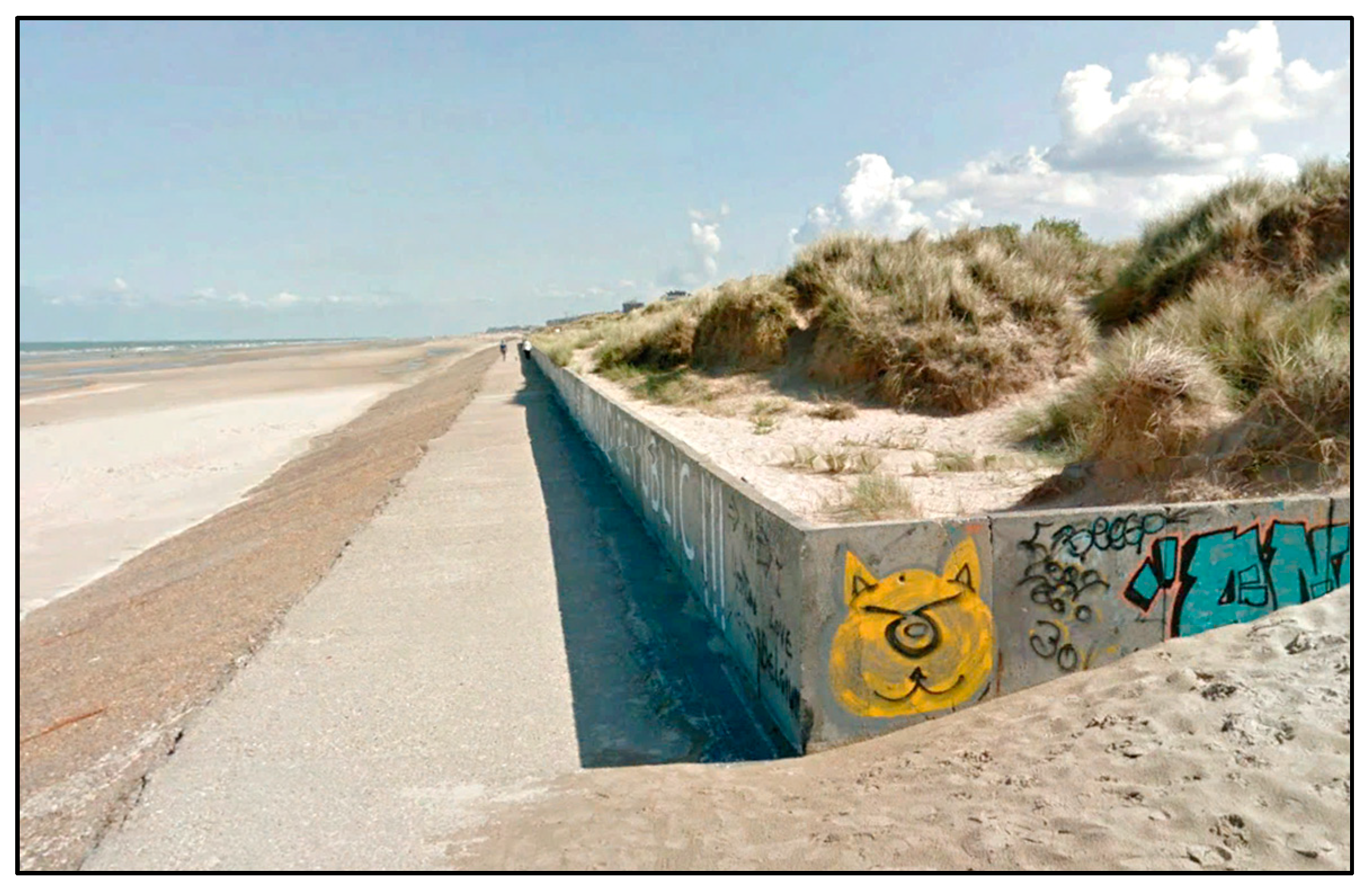

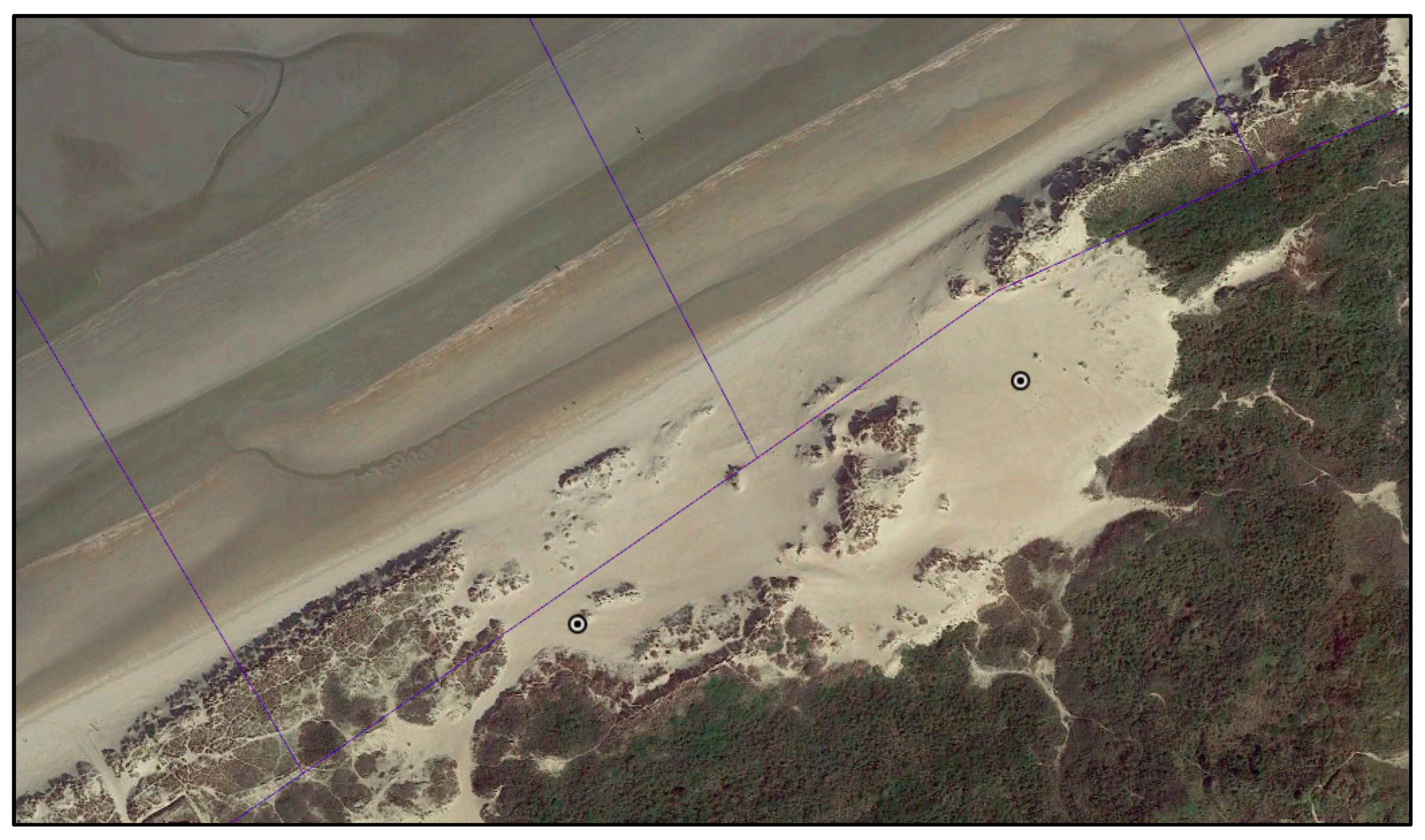
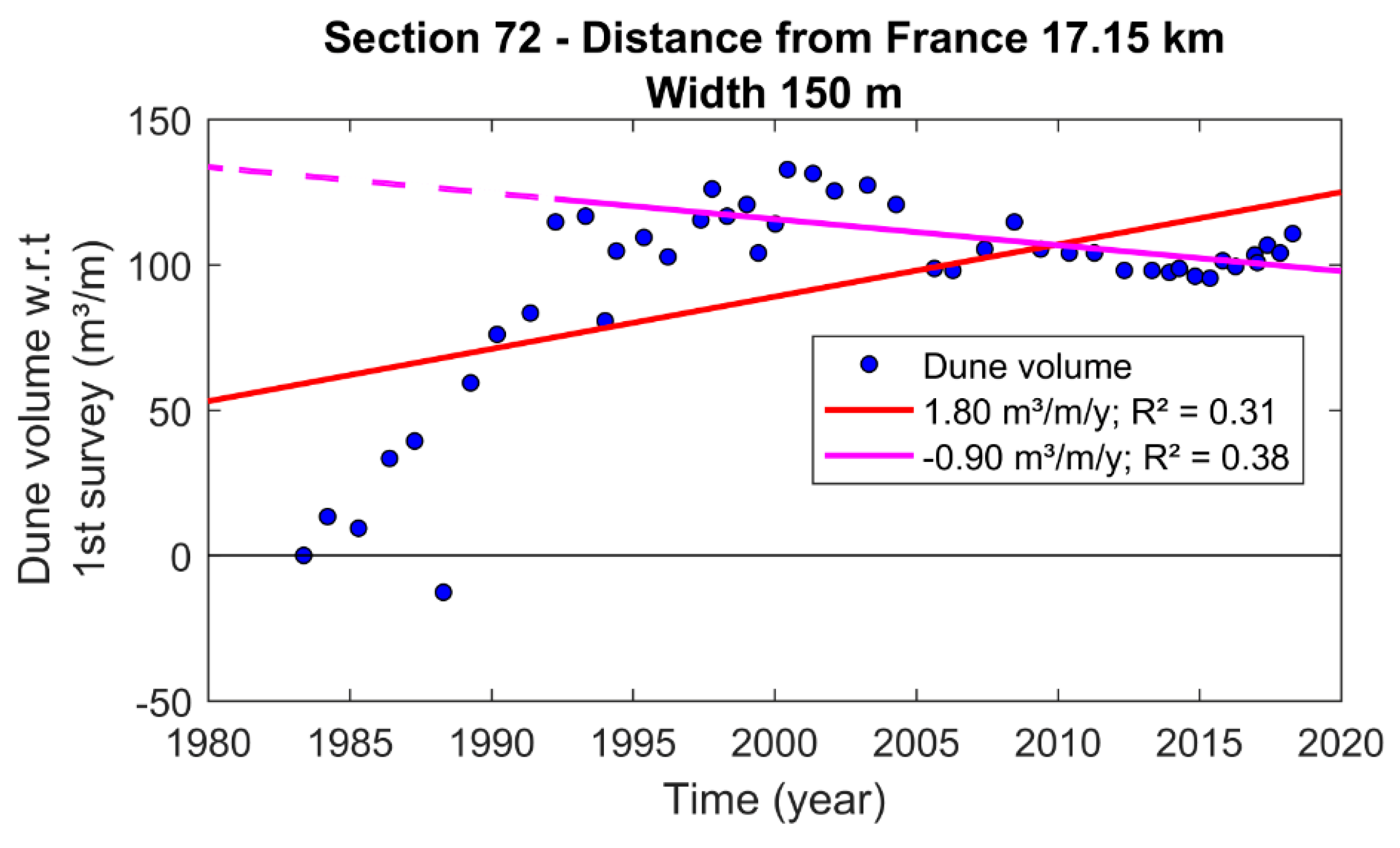
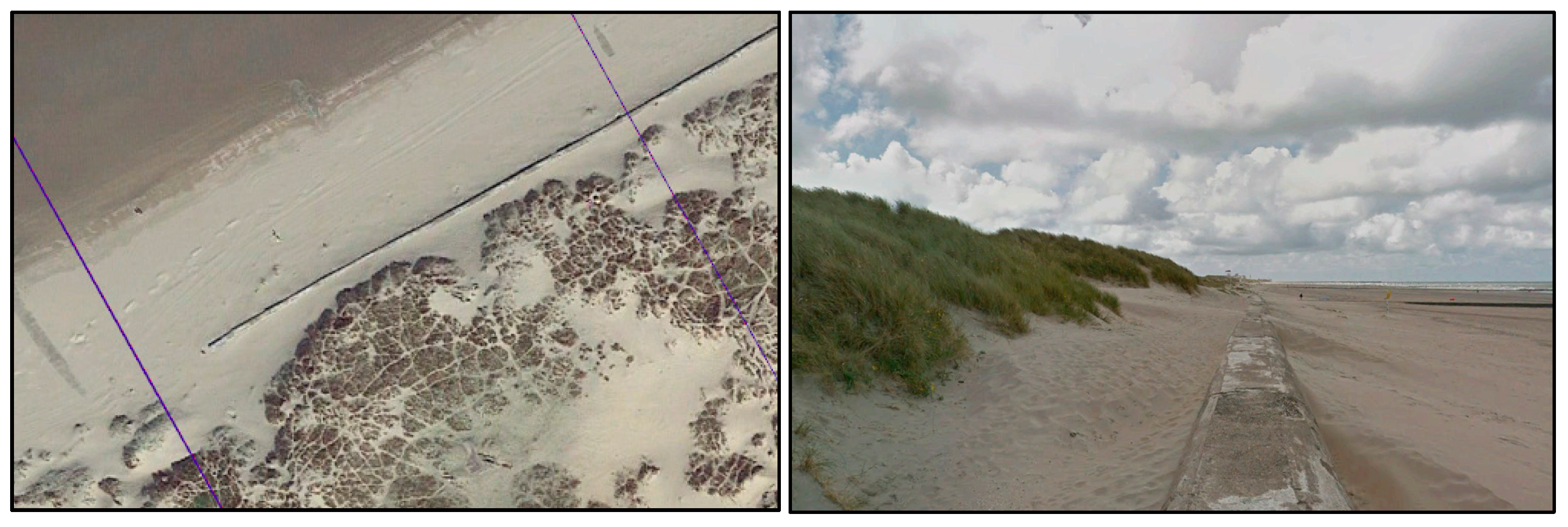
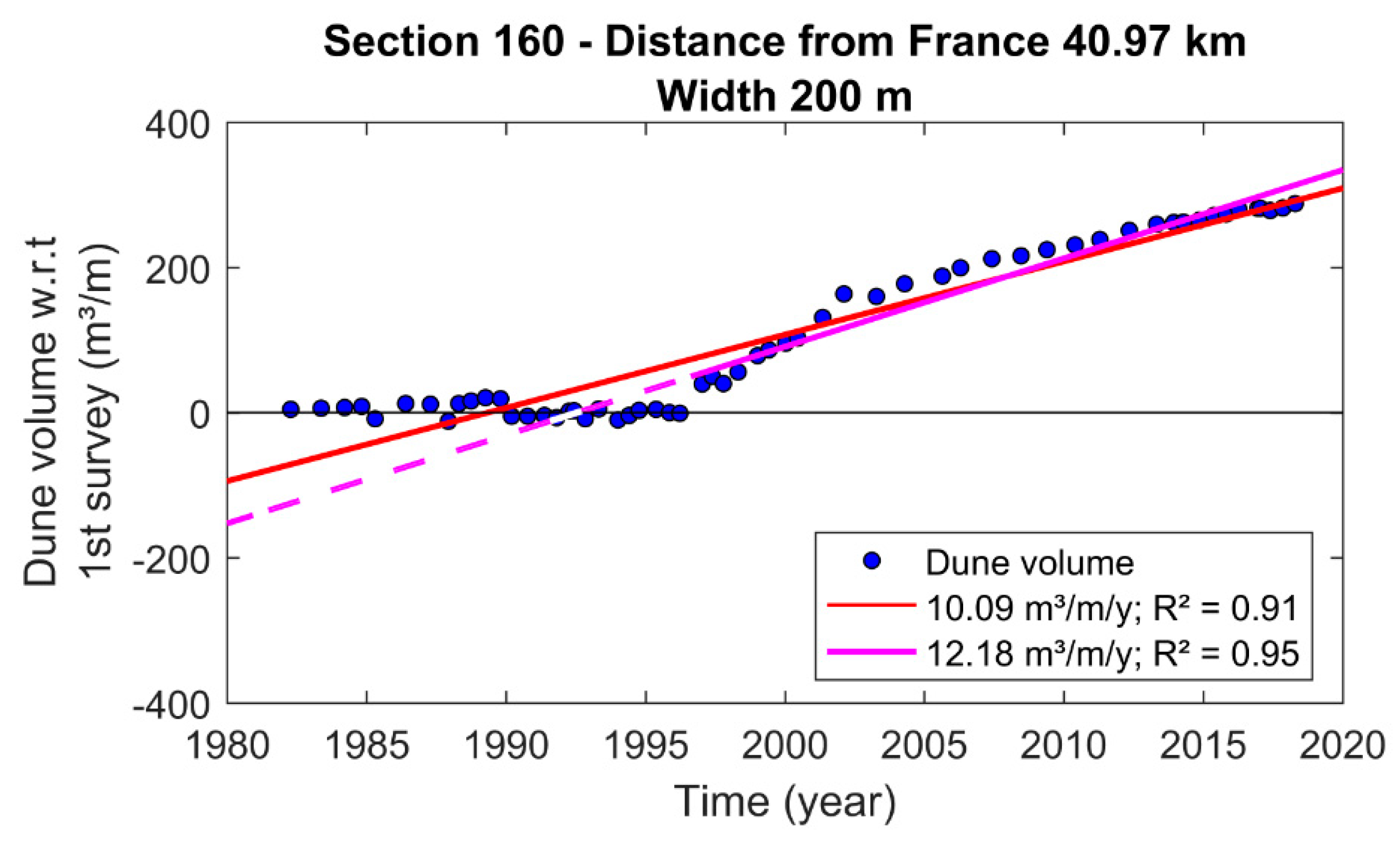

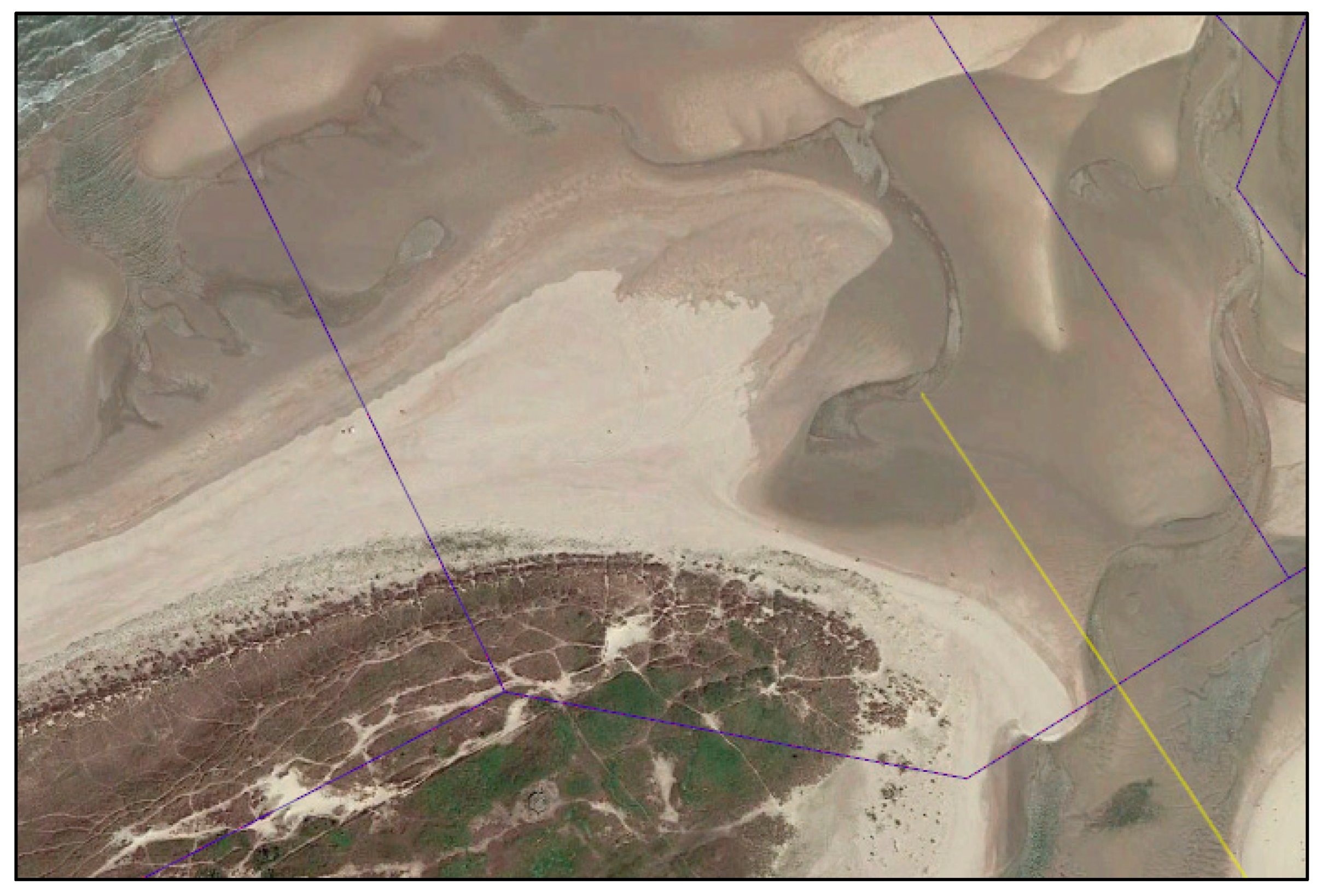
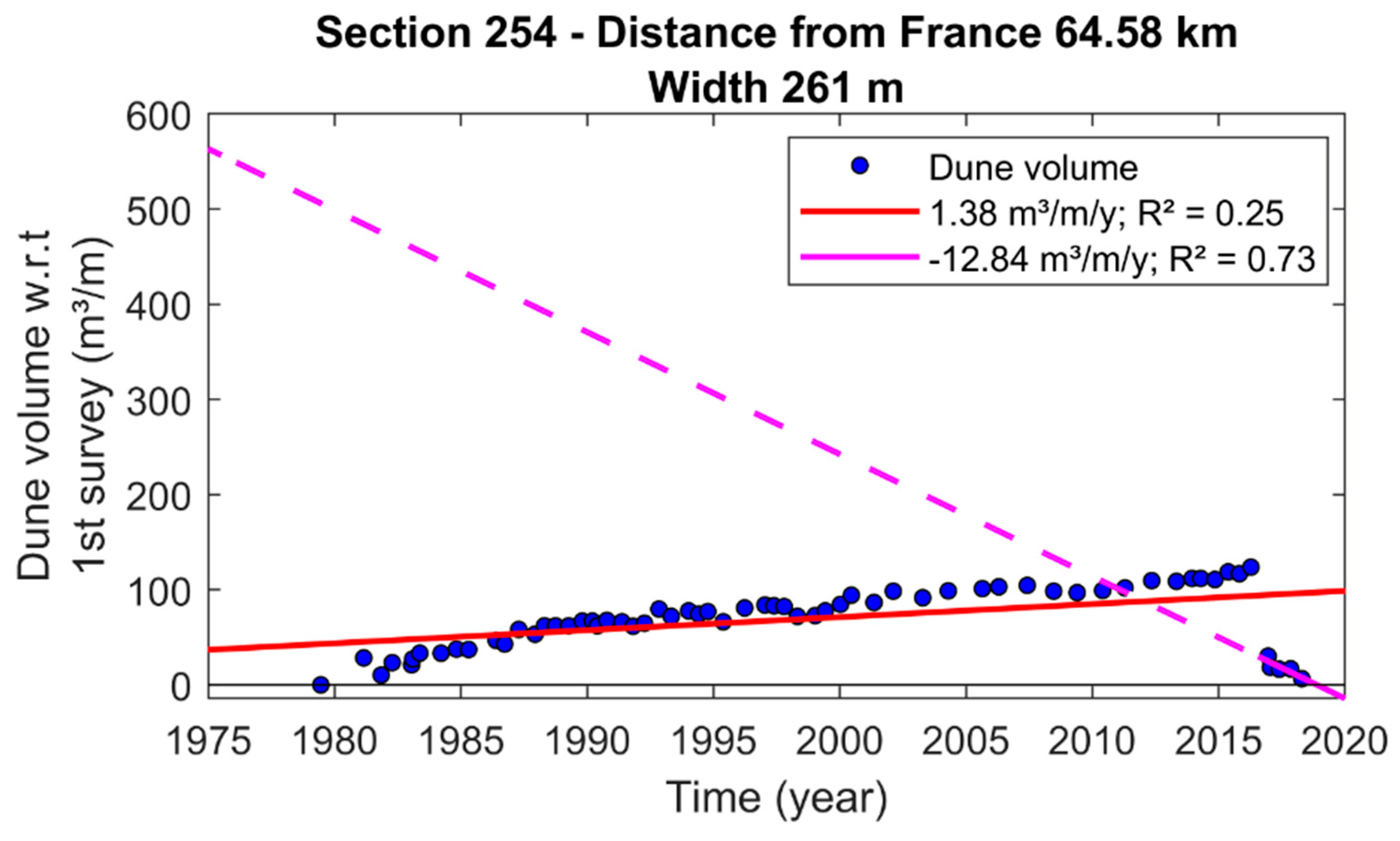


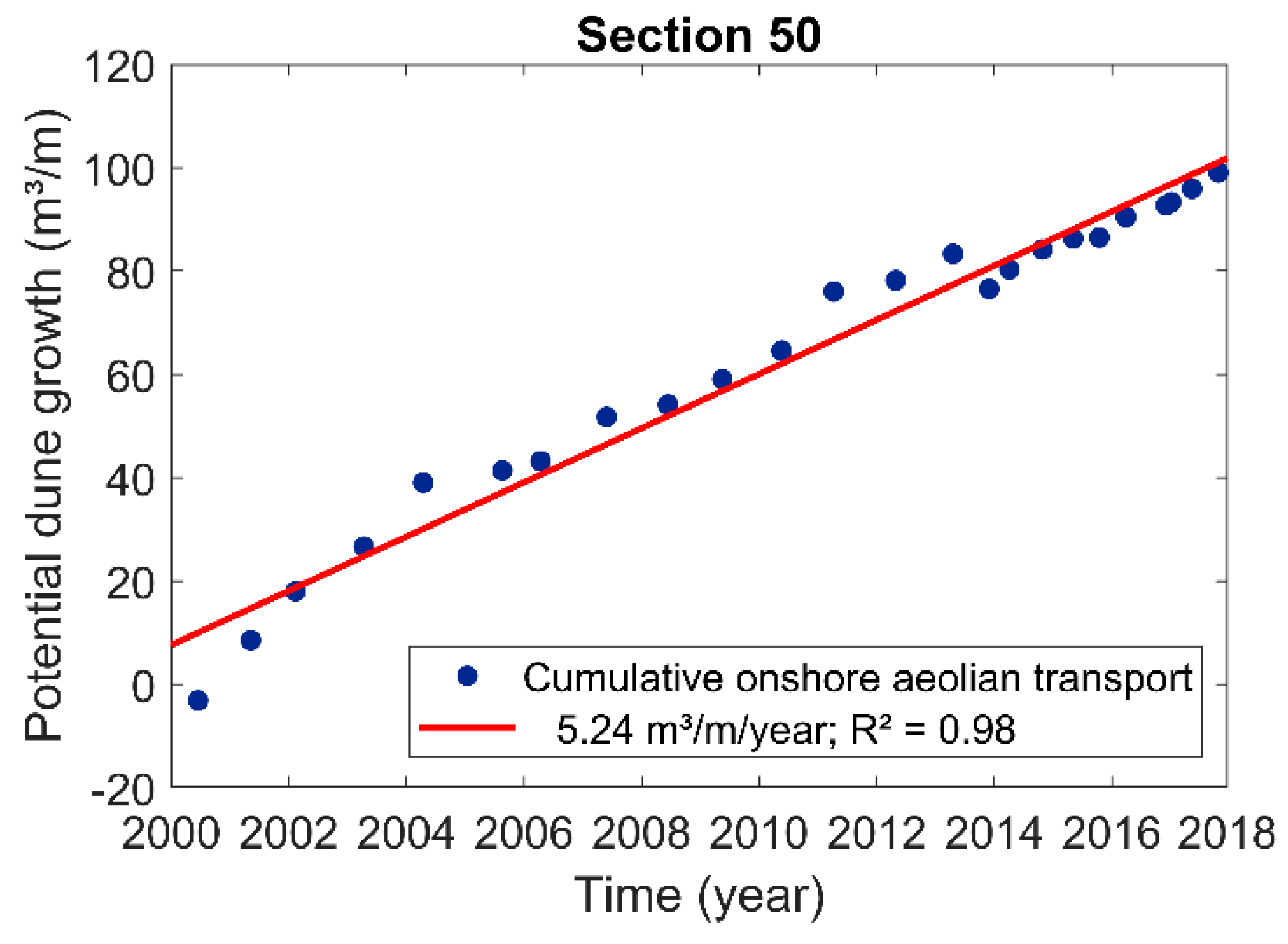
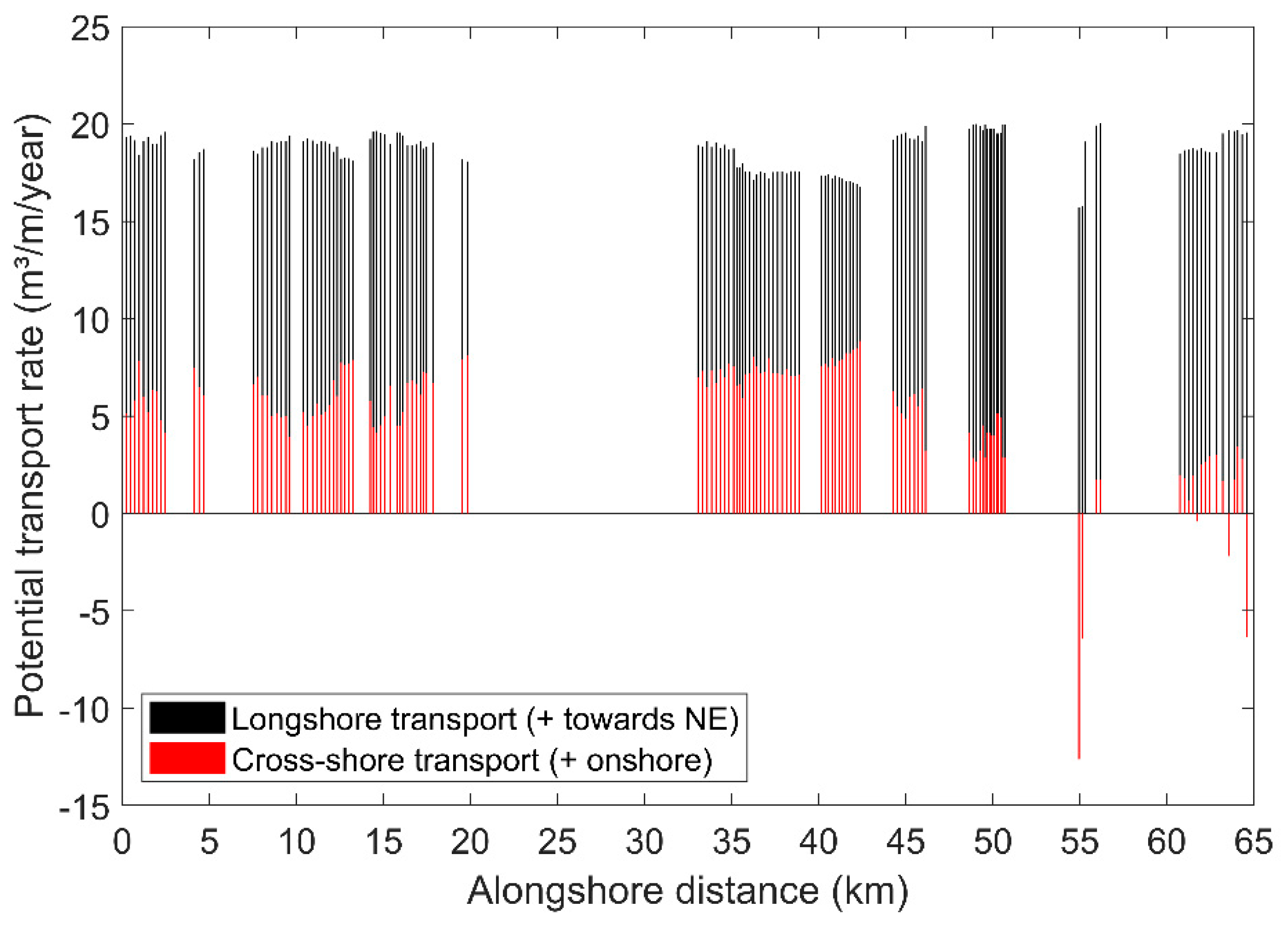

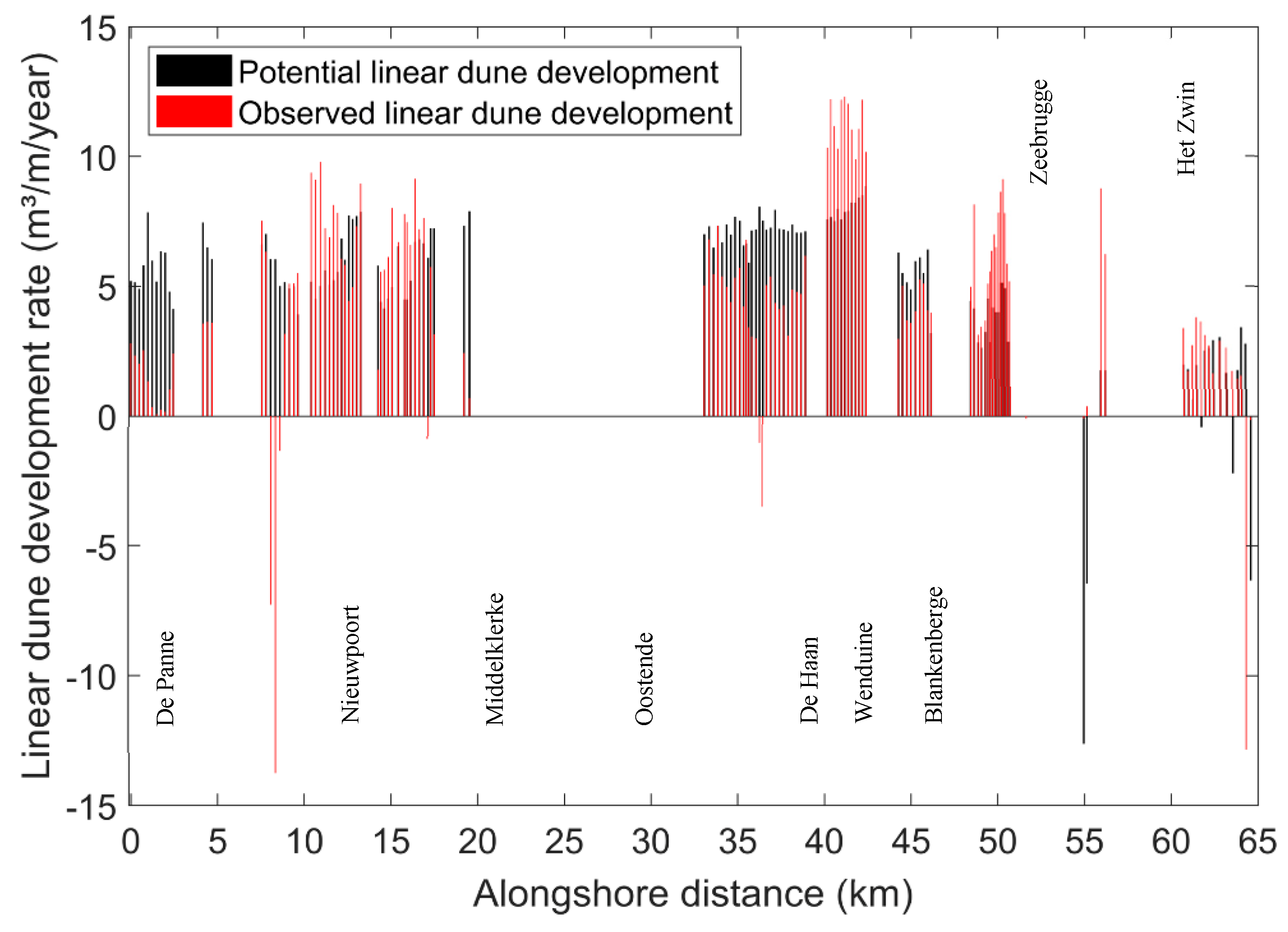
© 2019 by the authors. Licensee MDPI, Basel, Switzerland. This article is an open access article distributed under the terms and conditions of the Creative Commons Attribution (CC BY) license (http://creativecommons.org/licenses/by/4.0/).
Share and Cite
Strypsteen, G.; Houthuys, R.; Rauwoens, P. Dune Volume Changes at Decadal Timescales and Its Relation with Potential Aeolian Transport. J. Mar. Sci. Eng. 2019, 7, 357. https://doi.org/10.3390/jmse7100357
Strypsteen G, Houthuys R, Rauwoens P. Dune Volume Changes at Decadal Timescales and Its Relation with Potential Aeolian Transport. Journal of Marine Science and Engineering. 2019; 7(10):357. https://doi.org/10.3390/jmse7100357
Chicago/Turabian StyleStrypsteen, Glenn, Rik Houthuys, and Pieter Rauwoens. 2019. "Dune Volume Changes at Decadal Timescales and Its Relation with Potential Aeolian Transport" Journal of Marine Science and Engineering 7, no. 10: 357. https://doi.org/10.3390/jmse7100357
APA StyleStrypsteen, G., Houthuys, R., & Rauwoens, P. (2019). Dune Volume Changes at Decadal Timescales and Its Relation with Potential Aeolian Transport. Journal of Marine Science and Engineering, 7(10), 357. https://doi.org/10.3390/jmse7100357




